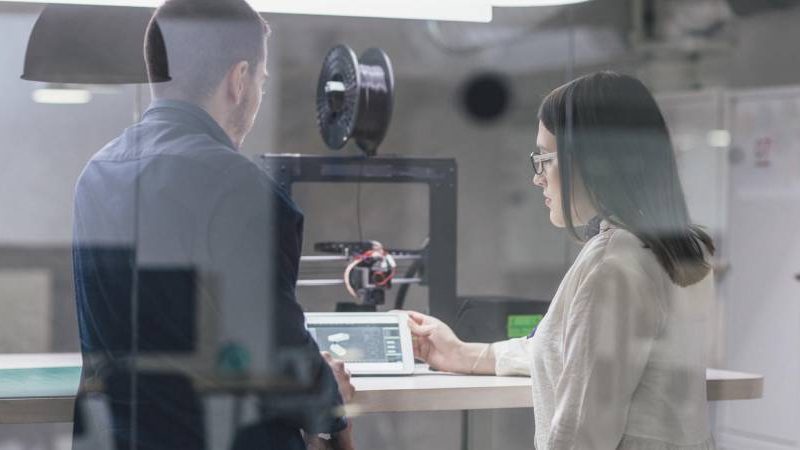by Máire Lane, PhD & Joseph Gunderson, Invesco Canada
It’s an exciting time in the world of 3D printing. This technology, which involves creating a three-dimensional object out of layers of material added together, is being used in a wide range of increasingly different applications.
3D printing is already playing a major role in health care, with many researchers working on ways to 3D print human organs.1 Around the world, builders and developers are finding creative ways to make use of this technology as well. In Prague, the world’s first 3D-printed parkour park recently opened.2 Meanwhile, an entire town of 3D-printed homes has been built in Mexico.3 3D printing’s applications even extend beyond Earth; the European Space Agency is testing the ability to 3D print spare parts in space, to be used for a potential future moon base.4
While many of us have heard about the concept of 3D printing, this technology has yet to really impact our daily lives the way some other major innovations have, and over the last several years, many companies that operate in this area have disappointed investors.
One of the tenets of our investment philosophy for Invesco Global Opportunities Class is the behavioural observation that humans tend to overestimate the progress that can be made in one year, and underestimate the progress that can be made in 10 years. Therefore, an area full of disruptive innovation like 3D printing, which has underwhelmed over the last few years, offers a set of very interesting opportunities over our forward looking 10-year investment horizon.
Where do we see the potential for growth?
Consider 3D Systems Corp., a major manufacturer of 3D printing hardware and materials. Based in Rock Hill, South Carolina, 3D Systems’ products allow the design and production of all manner of shapes and prototypes. Unlike traditional plastic manufacturing techniques, which are limited to shapes which you can mold or cut, 3D Systems’ products allow prototype designers virtually boundless flexibility. The company has cleaned up or sold off some ancillary businesses over the last few years, and we feel it is in a much better competitive and financial situation now than in the past.
One of 3D Systems’ most important customers is the medical device company Align Technology, which has revolutionized the orthodontic industry. Rather than using traditional metal braces to fix crooked teeth, Align instead uses 3D Systems’ hardware to create customized plastic retainers based on the shape and pattern of each patient’s teeth.
Over the years, Align has 3D printed million of plastic aligners — each unique to the individual patient, as well as to the stage of treatment for each patient. Such mass customization simply wouldn’t be possible with traditional manufacturing techniques. The result is an orthodontic treatment that is faster, more comfortable, and more convenient for the patient than previous techniques.
3D Systems and Align are both American companies, but the 3D printing theme is a great example of why a global approach to investing is so important. This holistic perspective has led us to several other world-class 3D printing companies that are helping to transform their respective industries.
- SLM Solutions is a German company that specializes in 3D printing of metals. The “SLM” stands for Selective Laser Melting, which is a great description of the process this company’s hardware uses. Its most advanced machines use 12 lasers at once, all operating in perfect harmony with fine control and precision, to melt metal powders into the shapes and parts needed for its customers. SLM’s machines can work with a wide array of metals such as titanium, aluminum, iron, chromium, and all sorts of alloys, and it has customers across the aerospace and automotive industries (including Rolls Royce, GE, and Porsche), along with other industrial use cases. Such applications demand both durability and precision, and SLM’s expertise has been very important to innovation in these areas.
- Materialise is a Belgian provider of 3D printing software. It provides the means for people to interact with and program 3D printers, and to optimize the 3D printing process to ensure it happens in the most efficient way possible. Its software is currently used to design a wide variety of interesting goods, from custom eyewear, dynamic insoles for running shoes, and lightweight luggage. 3D printing software is a very specialized, niche industry right now, but we think Materialise has big potential for the future as these techniques become more widespread.
- BICO is a Swedish company that is one of the newer and most innovative businesses in our portfolio. It has the technology to 3D print human tissue, layering cells together to create different types of structures. They can produce skin cells for the purposes of cosmetics testing, or patient-specific heart tissue to aid people with damaged heart muscles after a cardiac episode. Over the long term, we think BICO’s technology can eventually be used to 3D print entire new organs, using a patient’s own stem cells to eliminate the reliance of donors and the risk of transplant rejection. BICO has partnerships with leading global firms and institutions, such as L’Oreal, Johnson & Johnson, and Harvard, and is a great example of the type of small, innovative firm to which our fund is designed to provide clients with exposure.
We continue to focus on the powerful structural growth trends that are playing out in the world economy, and on the small, innovative companies we believe are best positioned to capture the rewards that flow from these trends over a multi-year period. The changes taking place in areas like 3D printing can create significant economic value for investors over our 10-year investment horizon, and we remain excited about the potential for these companies in the years to come.
1 Source: KXAN, “3D printed human organs? Work at Central Texas college could someday eliminate need for donors,” Sept. 10, 2021
2 Source: Archinect.com, “The world’s first 3D-printed parkour park is unveiled in Prague,” Oct. 5, 2021
3 Source: The New York Times, “How an 11-Foot-Tall 3-D Printer Is Helping to Create a Community,” Sept. 28, 2021
4 Source: AutoEvolution.com, “ESA Considers 3D Printing Spare Parts in Space Using Materials Found on the Moon,” Oct. 7, 2021
This post was first published at the official blog of Invesco Canada.














